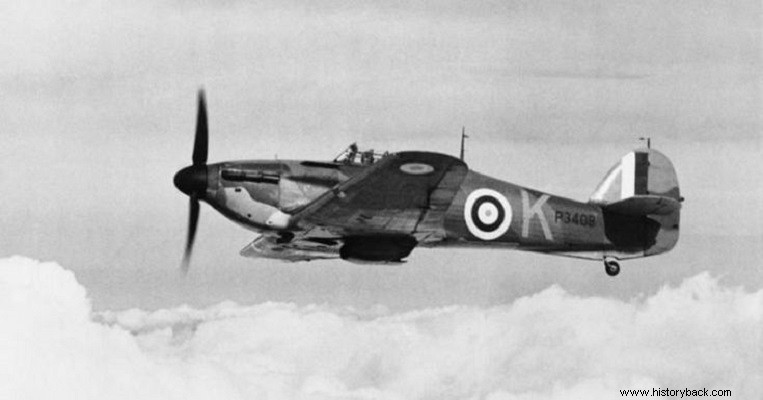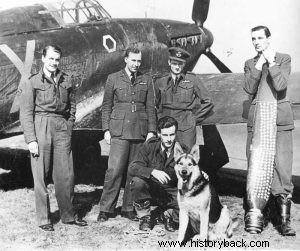
Initially he wanted to be a surgeon. But he could not stand the sight of blood. He enlisted in 1938 in the RAF and as a fighter pilot took part two years later in one of the most iconic aerial conflicts of World War II, the Battle of Britain. He survived the war having been shot down four times, once his parachute failed to open properly, and he narrowly escaped capture by a German patrol in April 1945 in Northern Italy as the Germans retreated from southern Europe. He himself at the age of 101 states through his son Brian Hemingway that he "still thinks of himself as a professional RAF fighter pilot, who did his duty and obeyed orders, and was lucky to survive when many did not , including his closest friend.”
"He never dreamed of becoming a fighter pilot, love came later," Brian Hemingway, who in 2018 found out that his father had been wrongly included in a list of deceased World War II pilots, tells APE-MPE and Vasilis Pia , and the error was fixed. "They had lost touch and dad wasn't involved in any of the (veterans) associations ... he was just overlooked as he's a loner." Except that Captain John Paddy Hemingway was by no means lonely and isolated in Britain's "darkest hour", in the years of the Second World War, when according to the words of the then British Prime Minister Winston Churchill, "those summer days of 1940, which followed after the collapse of France we were all alone." Paddy Hemingway had given enough before the "present", before "the raging storm that has been slowly gathering for so long finally burst upon us", as the British Prime Minister said.
"In 1937, his father took him to London to interview with the RAF and the following year he qualified for a short stint," reports his son Brian Hemingway. “He had been selected for fighter training when only 10% (of applicants) became fighter pilots – the rest went into bombers. It was a whole process," he adds. As the airfield sirens at Debden, north-east of London, screamed that midnight on September 3, 1939, three Hurricane destroyers were taxiing with engines at full blast for the first defense patrol, for everyone knew that Britain had been at war for a few hours. with Nazi Germany. "I was one of three Hurricanes ordered to take off," John Hemingway recalls, "we were certainly the first flight of the war from Debden, and probably one of the first missions. We saw nothing and landed fifty minutes later. I fell asleep dry knowing that everything had definitely changed, doubting the future".
Battle of France – the first down
On May 10, 1940, after eight months of inactivity, 155 German divisions breach the Dutch border and enter the Netherlands. The German troops "flowed towards France", without the French army together with the British Expeditionary Force being able to contain them. Paddy Hemingway with the RAF's 85 Squadron is in Normandy providing air cover. That day he will also shoot down his first German plane, a Heinkel 111 bomber, while the next day he will also be shot down by anti-aircraft near Maastricht. Injured in the leg, after a heavy forced landing he would miraculously return after three days to his squadron, to find as he reports that “the base had been bombed and most of the pilots were no longer there… they had been shot down, captured or killed. Many of our planes were damaged, I think 19 were destroyed in just ten days." Within six weeks the Dutch, Belgians and French had capitulated, while the British Expeditionary Force was forced to retreat with the remnants of the French army – via Dunkirk – across the Channel. 85 Squadron suffered the most casualties in France over ten days with seven pilots killed, five wounded, one captured and 25 Hurricanes destroyed.
Battle of Britain:Light in the Darkest Hour...
“The Battle of France, as General Weigan called it, is over. The Battle of Britain is about to begin," said British Prime Minister Winston Churchill in the House of Commons on June 18, 1940. Three days earlier Paddy Hemingway had returned with the 85th Squadron to Essex. From there he would face waves of German bombers who wanted to drag the RAF fighters into battle to destroy them, with the aim of the German Luftwaffe taking control of the air so that the landings on Britain could begin. "In June and July 1940, 85 Squadron was reorganized and brought back to full operational readiness under Squadron Leader Peter Townsend and based at Debden," reports Brian Hemingway.
August 18, 1940 is a day John Hemingway cannot easily forget as the battle reaches its peak. His best friend is killed in air combat, while he is shot down over the English Channel and parachutes into the stormy sea. "He almost drowned," adds his son. Eight days later he would abandon his aircraft again when twelve Hurricanes of No. 85 Squadron faced 250 Dornier bombers in a frontal attack. Pulling the string of his parachute he will fall to the land without a scratch.
In March 2019 pieces of his plane were found after an excavation in Essex, including the controls with the switch in the "fire position". In the last days of August 1940 the RAF's Fighter Command is under suffocating pressure. The Luftwaffe pound airfields, radar stations along the south coast, and night bombing of London and other cities begins. "By early September the 85th Squadron was deserted again, only seven pilots out of eighteen remaining. Dad remembers suffering from extreme exhaustion,” says son Hemingway. The squadron was temporarily withdrawn to the rear, only to return to operations in November 1940 as a night pursuit squadron, a pioneer in combat tactics, with the slogan "we chase day and night".
"He mainly flew A-20 Havoc with some success, shooting down several Heinkel 111s," Mr. Hemingway points out. "It is the first time in a conflict of humanity that so many owe so much to so few," said British Prime Minister Winston Churchill on August 20, 1940, describing the brave airmen who fought in the Battle of Britain.
RAF Commodore Chris Elliott, head of the Charity Fund, refers to these airmen:“We often talk about 'The Few', the fighter pilots who took to the skies during the Battle of Britain. Their contribution was outstanding and it is important to remember them and their experiences. Paddy Hemingway belongs to a generation of men who came from ordinary families to do remarkable things in defense of their country. They answered the call of their country, and I am honored to follow in their footsteps during my own RAF career and continue to repay the debt we all owe them."
The Battle of Britain (10 July – 31 October 1940) of which the UK is celebrating its 80th anniversary this year is as important in military history as the Battle of Waterloo or the Naval Battle of Trafalgar. It was a turning point for the British when they stood alone against Hitler's seemingly unstoppable military might. It is the first independent air battle between two states. It marked the first battle won by air power alone. For the first time in aviation history, radar was used as the primary air defense system, guiding British fighters to the points of invasion.
The Luftwaffe was unable to gain control of the air, much needed for the Germans to launch Operation Sea Lion, the planned invasion of Britain. The most decisive role was played by the RAF's Fighter Command, with a total of 2917 pilots, who faced the waves of German bombers and fighters. Of these, 583 had come from abroad, even from occupied countries (20% of the total). 544 were killed in the operations and over 400 were injured. 800 were later lost on other fronts of the war.
Commander John Paddy Hemingway was awarded the Distinguished Flying Cross (DFC) in 1941, and after the Battle of Britain, he became involved in training young fighter pilots. In total in the war he had shot down or destroyed seven enemy aircraft. From 1942 he was chief officer of a radar station, and directed Allied aircraft during the Normandy landings, while in February 1945 he returned to active duty as the commander of the 43rd Squadron and flew Spitfires in Italy "helping the Germans to withdraw", as he explains with British phlegm his son Brian. There he will be shot down for the fourth time over Ravenna on April 23, 1945, where his war finale will be given by Italian partisans:A 10-year-old girl leads him behind the German lines to salvation.
John Paddy Hemingway would remain in the RAF after the war, retiring in 1969 with the rank of squadron leader. At 101 years old he lives in a nursing home near Dublin. As his son states, "he never forgets that he was one of the 3,000 pilots and 300,000 men of the RAF who won the Battle of Britain, and feels privileged to have met so many admirable young men and pilots who were lost in the war." As he himself says "he is indeed a lucky Irishman".

Hemingway, left, with colleagues in front of a Hurricane.
SOURCE:APE-ME
